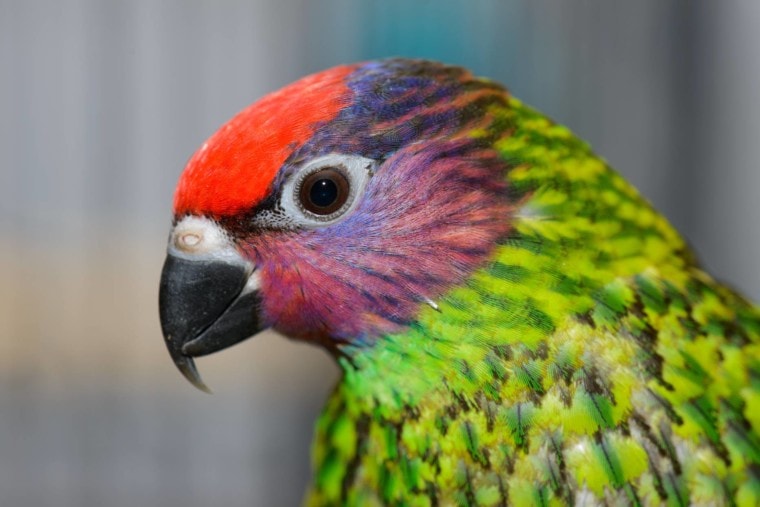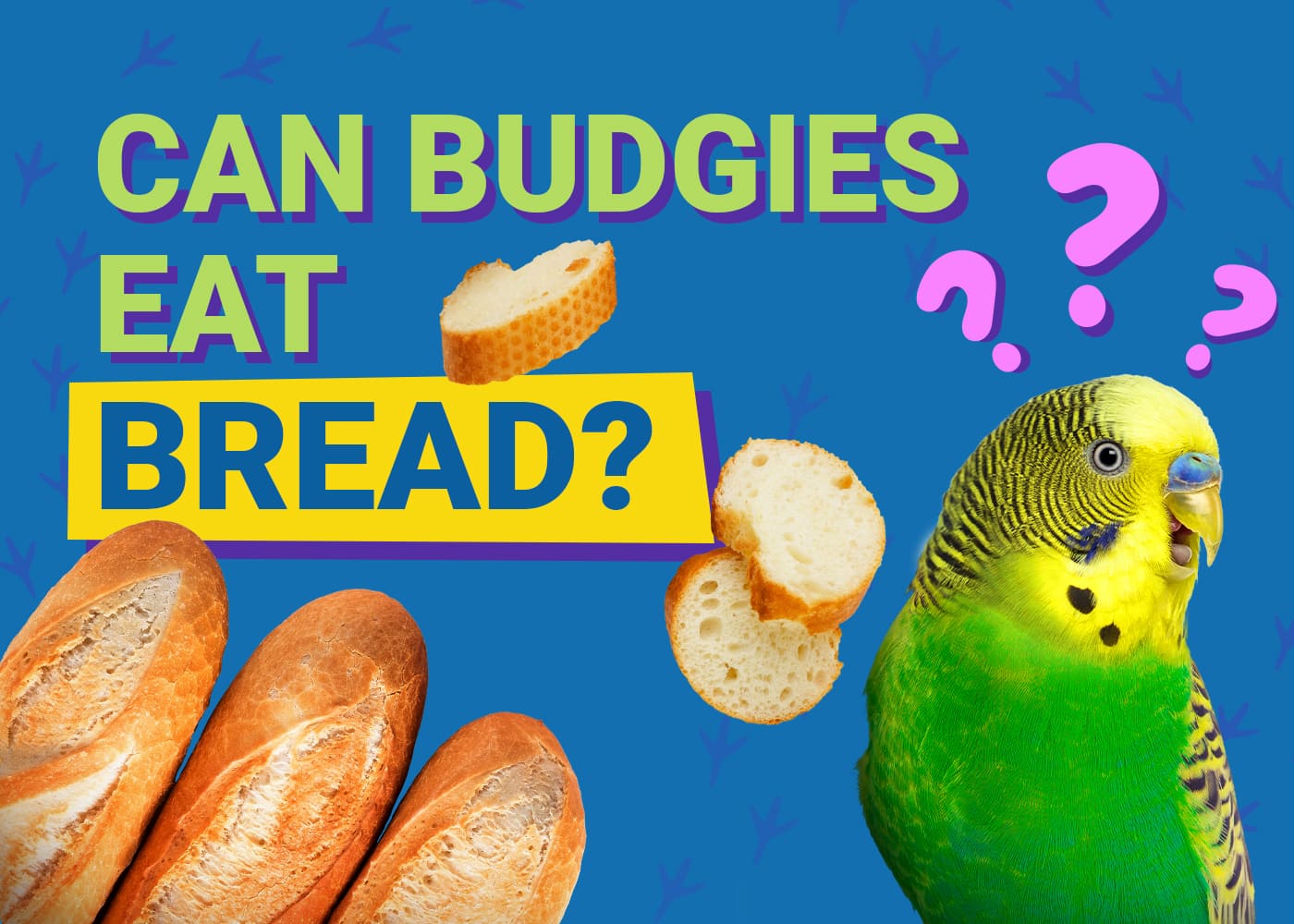
Goldie’s Lorikeet is one of a kind. This tiny, colorful member of the parrot family is the only species in the genus Glossoptilus. It’s also an absolute joy to keep, as it exhibits the cutest behaviors, like wrapping itself up in a blanket to sleep.
Be careful though, as adorable as it is, this is not a beginner-friendly pet bird. Indeed, its specific dietary needs don’t make it a good option for owners with less experience in the wonderful world of winged pets. But if you’re up to the challenge, you’ll definitely fall in love with this watermelon-colored little bird! So, read on to find out everything you need to know about its personality, dietary needs, and care.
 Species Overview
Species Overview
| Common Names: | Goldie’s Lorikeet |
| Scientific Name: | Glossoptilus goldiei |
| Adult Size: | 7½ inches |
| Life Expectancy: | 11 to 15 years in captivity |
Origin and History
The discovery of this little treasure with shimmering plumage is attributed to Scottish ornithologist Andrew Goldie, who first saw it in the lush forests of New Guinea. Then, in 1882, Goldie’s Lorikeet was formally described by another ornithologist, Richard Bowdler Sharpe. He gave it the scientific name of Trichoglossus goldiei and placed it in the genus Psitteuteles. However, a recent phylogenetic study published in 2020 moved Goldie’s Lorikeet to a new genus, Glossoptilus, where it reigns as the sole king of its kingdom—until more species are discovered!

Temperament
Goldie Lorikeets are gregarious birds that love to fly in groups of 30 or more in their natural habitat.
As pets, these adorable little birds captivate with their easy-going and calm personalities. They are indeed relatively silent, even shy, non-aggressive, playful, non-messy, and they enjoy the company of their fellows, whether they are of the same species or not. Additionally, Goldie’s Lorikeets can be housed as a single pair or grouped in a mixed-species aviary. They are also fascinating to observe when they interact with their cage mates!
Also, although they are less skilled than other parrots at imitating the human voice, some of these lorikeets will make you smile by trying to reproduce sounds with their squeaky little voices.
Speech & Vocalizations
Goldie’s Lorikeet has many qualities, but its call is unfortunately not on this list: indeed, it is a single piercing note, high pitched and lacking harmony.
Nevertheless, there seems to be a difference of opinion among the owners of this bird: some claim that Goldie’s Lorikeets give pleasant chirps and that they very rarely utter high-pitched calls. Perhaps this is because they keep a couple of individuals together, and the lorikeets, happy to have constant company, have less need to cry out for your attention.
Therefore, it is difficult to know what exactly your lorikeet’s vocalizations will be, but be aware that a bird of this species will be happier and arguably quieter if kept with other Goldie’s.
Goldie’s Lorikeet Colors and Markings
Easily recognizable among its other parrot congeners, Goldie’s Lorikeet has a bewitching plumage: a pale green belly spotted with yellow, a back with dark green feathers streaked with black, purple cheeks, indigo blue feathers around the eyes, crowned by a pretty scarlet forehead.
As in many birds, there is a sexual dimorphism: adult females have a duller red forehead, as do the rest of the colors of the entire plumage.
Furthermore, there are no known natural mutations and other color variations for this species.
 Caring for the Goldie’s Lorikeet
Caring for the Goldie’s Lorikeet
Housing
Goldie’s Lorikeets will thrive in a large cage and, ideally, an aviary. This aviary should measure at least 40 inches high by 30 inches wide. If you plan to (and you should!) acquire more than one individual, buy an even larger cage, especially if you can’t let them out daily to spread their wings.
This species also likes to snuggle up in a nest to sleep; make a bottom nest with holes in it, with an opening at least 4 inches high. You can fill the nest with a substrate of wood chips. The bottom of the aviaries must be covered with sand in a sufficient layer to be changed every 8 months.

Enrichment
Lorikeets need to be entertained: their cage must therefore be equipped with accessories that reproduce their natural environment. Decorate their cage with many perches, tree branches, toys suitable for this type of bird, feeders, waterers, cuttlefish bones (for their mineral needs), and small mirrors.
Temperature
Lorikeets tolerate temperatures between 59°F and 77°F; therefore, if you live in a colder climate, you must provide a small heater for the room where the cage or aviary is located.
Grooming
These colorful little clowns love to frolic in the water every day: you can install a small birdbath to enjoy the show!
Note: Keeping the cage and accessories spotlessly clean is essential to prevent the growth of bacteria and other unwanted guests. Indeed, several diseases and health problems can be avoided if you keep their environment free of dirt.

Common Health Problems
Goldie’s Lorikeets can live in captivity for up to 15 years. They are small birds with fairly robust health, but they can suffer from health problems common to parrots:
Psittacine beak and feather disease (PBFD)
This severe viral disease is characterized by loss of feathers, atrophy of the beak and legs, loss of pigment from the entire plumage, and bloody shafts. It is common in most bird species and particularly affects juveniles.
Besides, it is a highly contagious disease: if you notice any of your birds is infected, you should quarantine it immediately. Unfortunately, euthanasia may be recommended to prevent the spread of illness and stop your little bird from suffering needlessly. There is currently no treatment for PBFD.
Psittacosis
Psittacosis is a zoonosis, an infectious disease transmissible through contact with a sick bird but also contagious to humans. Symptoms of psittacosis are loss of balance and weight, difficulty in breathing, diarrhea, and weakness. Therefore, the entire cage should be disinfected carefully to eradicate this disease.
Moreover, there are few reliable references on the other diseases that Goldie’s Lorikeet may suffer from. As a preventive measure, visit your veterinarian at least once a year for a check-up. Even if your bird appears to be in great shape, a physical exam can identify health problems early on and often works best. This is because the signs of illness often only appear when the bird is very sick and unable to hide its symptoms. For example, he may have a tendency to puff up his feathers all the time, have difficulty breathing, be lethargic, lose weight, or stop eating altogether.
If you notice any of these signs on your lorikeet, please contact your veterinarian immediately.
Diet and Nutrition
Goldie’s Lorikeets have particular nutritional needs. Indeed, unlike other species of birds kept in captivity, these lorikeets feed mainly on nectar, pollen, and berries.
Due to this specialized diet, lorikeets have a unique tongue. The tongue has papillae at the end that make it look a bit like a brush. It helps them acquire food. So, when you interact with your bird, it may use its tongue to explore the contents of your hands. This can also be an excellent way to strengthen your bond with your little lorikeet.
Lorikeets also like honey, fruits (such as apples, papaya, cantaloupe, kiwi), and some vegetables. Flowers, including hibiscus, marigolds, and dandelions, are another healthy addition to their diet. In addition, all fruits, vegetables, and flowers must be free of pesticides and preferably organic.
In summary, feeding Goldie’s lorikeets in captivity should consist of:
It is also possible to buy specific food for lorikeets in certain pet stores and from specialists.
Exercise
Goldie’s Lorikeets need several hours outside the cage each day and need a large cage as well as a place to bathe. They should be kept in pairs at a minimum! Therefore, provide them with a cage at least 48 inches high by 40 inches wide, which is enough for two birds.

Where to Adopt or Buy a Goldie’s Lorikeet
Goldie’s Lorikeets aren’t the easiest to find. Do some research on local breeders first, and do not hesitate to ask them a lot of questions, especially about the breeding conditions of their birds and the temperament of the bird you want to adopt. Be aware that a baby Goldie Lorikeet will cost you between $250 and over $1,000, depending on the breeder and your region.
You can also focus your research on reputable websites, such as Bird Breeder, Central Florida Parrot Rescue & Parrot Sanctuary Inc., or AdoptAPet.com.
 Final Thoughts
Final Thoughts
There are few birds as adorable as Goldie’s Lorikeets. But they are not ideal companion birds for beginners due to their very special dietary needs. Also, if your dream is to chatter all day with your little bird, adopting a parakeet or other species of parrot would make more sense. But, if you have done your research well and feel ready to welcome Goldie’s Lorikeet into your family, you will be won over by the crazy charm of this colorful tiny bird!
- Related Read: Blue Lorikeet
Featured Image Credit: CrystalMage, Shutterstock

 Species Overview
Species Overview Final Thoughts
Final Thoughts





